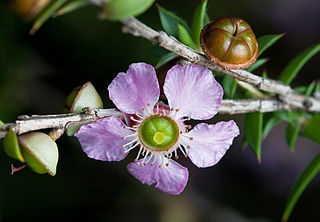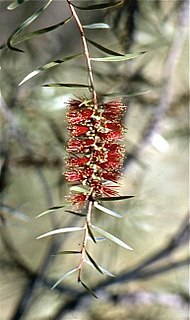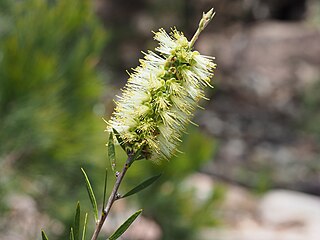
Leptospermum is a genus of shrubs and small trees in the myrtle family Myrtaceae commonly known as tea trees, although this name is sometimes also used for some species of Melaleuca. Most species are endemic to Australia, with the greatest diversity in the south of the continent, but some are native to other parts of the world, including New Zealand and Southeast Asia. Leptospermums all have five conspicuous petals and five groups of stamens which alternate with the petals. There is a single style in the centre of the flower and the fruit is a woody capsule.

Homoranthus is a genus of about thirty species of plants in the myrtle family Myrtaceae and all are endemic to Australia. Plants in this genus share similarities with those in both Darwinia and Verticordia. They are shrubs with their leaves arranged in opposite pairs and with flowers appearing either singly or in small groups, usually in upper leaf axils. They are found in Queensland, New South Wales and South Australia. The genus was first described in 1836. None of the species is common nor are they well-known in horticulture.

Melaleuca alternifolia, commonly known as tea tree, is a species of tree or tall shrub in the myrtle family, Myrtaceae. Endemic to Australia, it occurs in southeast Queensland and the north coast and adjacent ranges of New South Wales where it grows along streams and on swampy flats, and is often the dominant species where it occurs.

Melaleuca comboynensis, commonly known as cliff bottlebrush, is a plant in the myrtle family, Myrtaceae and is endemic to New South Wales and Queensland in Australia. It is usually a shrub, similar to Melaleuca citrina with its hard leaves, spikes of red flowers and clusters of cup-shaped fruits but differs in that its leaves are generally wider and its habitat is usually rocky outcrops rather than along watercourses.

Verticordia is a genus of more than 100 species of plants commonly known as featherflowers, in the myrtle family, Myrtaceae. They range in form from very small shrubs such as V. verticordina to trees like V. cunninghamii, some spindly, others dense and bushy, but the majority are woody shrubs up to 2.0 m (7 ft) tall. The flowers are variously described as "feathery", "woolly" or "hairy" and are found in most colours except blue. They often appear to be in rounded groups or spikes but in fact are always single, each flower borne on a separate stalk in a leaf axil. Each flower has five sepals and five petals all of a similar size with the sepals often having feathery or hairy lobes. There are usually ten stamens alternating with variously shaped staminodes. The style is simple, usually not extending beyond the petals and often has hairs near the tip. All but two species are found in Southwest Australia, the other two occurring in the Northern Territory.
Verticordia verticordina is a flowering plant in the myrtle family, Myrtaceae and is endemic to a small area near the coast of the south-west of Western Australia. It is a small, low-growing shrub with crowded leaves and in spring, scattered pale greenish-cream and golden brown flowers. Its unusual flowers and fleshy leaves give the plant a superficial resemblance to a Darwinia.

Homoranthus wilhelmii, commonly known as the eastern feather flower, is a species of flowering plant in the family Myrtaceae and is endemic to South Australia. It is a small, spreading shrub with cylindrical to flattened leaves and white or pink flowers arranged in corymbs on the ends of branchlets. The distribution includes an area on the Yorke Peninsula, but it is most common on the southern Eyre Peninsula.

Melaleuca subulata is a plant in the myrtle family Myrtaceae, and is endemic to south eastern Australia.. It is a small, spreading shrub with hard bark, dense foliage, cylindrical leaves and spikes of dark crimson flowers in summer.

Darwinia glaucophylla is a plant in the myrtle family Myrtaceae which grows as a prostrate shrub, sometimes forming extensive mats. It has bluish green leaves and white flowers in small groups which fade to reddish pink as they age. It is only known from about fifteen sites in the Gosford area and is listed as "threatened" in New South Wales legislation.

Melaleuca chisholmii commonly known as Burra bottlebrush is a plant in the myrtle family, Myrtaceae and is endemic to Queensland. It is a shrub with rough bark, an open habit and spiky foliage but in winter has bright red flower spikes tipped with yellow.

Melaleuca flavovirens, commonly known as green bottlebrush is a plant in the myrtle family, Myrtaceae and is endemic to a small area near the New South Wales–Queensland border in Australia. It is a stiff shrub, distinguished by its silvery new growth and spikes of greenish flowers with yellow tips.

Verticordia ovalifolia, commonly known as oval-leaved featherflower, is a flowering plant in the myrtle family, Myrtaceae and is endemic to the south-west of Western Australia. It is an openly branched shrub with egg-shaped leaves and strap-like, feathery petals in spring.

Darwinia biflora is a plant in the myrtle family Myrtaceae and is endemic to New South Wales. It is an erect, often straggly shrub with flattened, glabrous leaves, and flowers which are arranged in pairs. The flowers are greenish in colour but each is surrounded by two purple-red bracteoles and have a long yellow-green style projecting out of the flower tube. The species only occurs in the Sydney region in a few places where shale-capped ridges intergrade with Hawkesbury sandstone.

Kunzea cambagei, commonly known as the Cambage kunzea is a flowering plant in the myrtle family, Myrtaceae and is endemic to a small area of New South Wales. It is a small shrub with egg-shaped leaves and clusters of cream-coloured to yellowish flowers near the end of the branches. It is only known from areas near Mount Werong in the Kanangra-Boyd National Park and Berrima.

Homoranthus cernuus is a plant in the myrtle family Myrtaceae and is endemic to a small area in the Wollemi National Park. It is a slender shrub with smooth, linear shaped leaves and pairs of pendulous cream-coloured flowers with a pinkish base.

Homoranthus thomasii is a species of flowering plant in the family Myrtaceae and is endemic to Queensland. It is a small shrub with spoon-shaped, greyish green leaves and small, pendulous, pink flowers in the upper leaf axils.

Boronia glabra, commonly known as sandstone boronia, is a plant in the citrus family Rutaceae and is endemic to eastern Australia. It is an erect or weak shrub with many branches, mostly glabrous leaves with a slightly paler underside, and bright pink, four-petalled flowers arranged singly in leaf axils.

Boronia granitica, commonly known as granite boronia, is a plant in the citrus family, Rutaceae and is endemic to a small area of eastern Australia. It is an erect shrub with many branches, compound leaves and pink, four-petalled flowers.
Leptospermum microcarpum is a species of shrub that is endemic to eastern Australia. It has elliptical to lance-shaped leaves with a sharp point on the tip, white flowers and small fruit that falls from the plant shortly after the seeds are released.

Prostanthera granitica, commonly known as the granite mintbush, is a species of flowering plant in the family Lamiaceae and is endemic to eastern Australia. It is a spreading shrub with egg-shaped leaves with the edges rolled under, and purple to violet flowers.



















